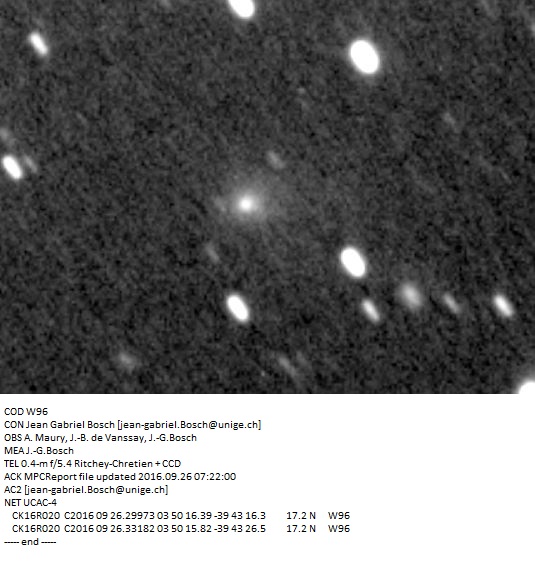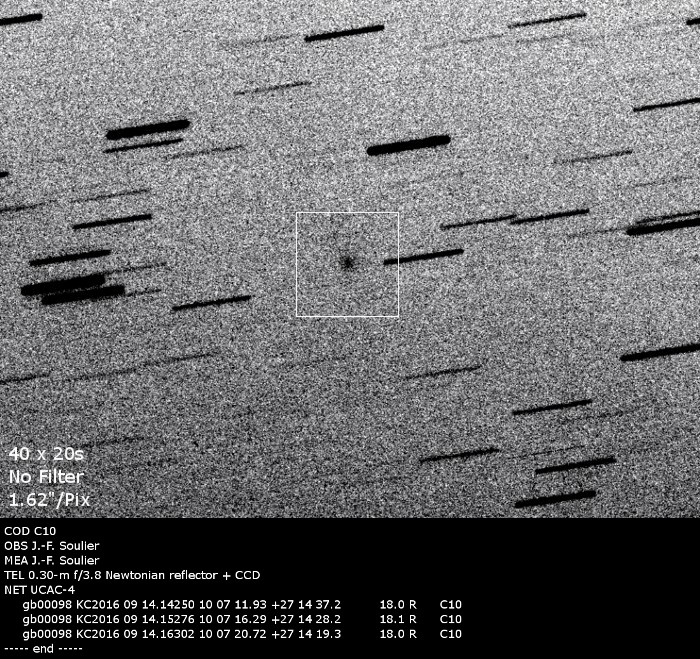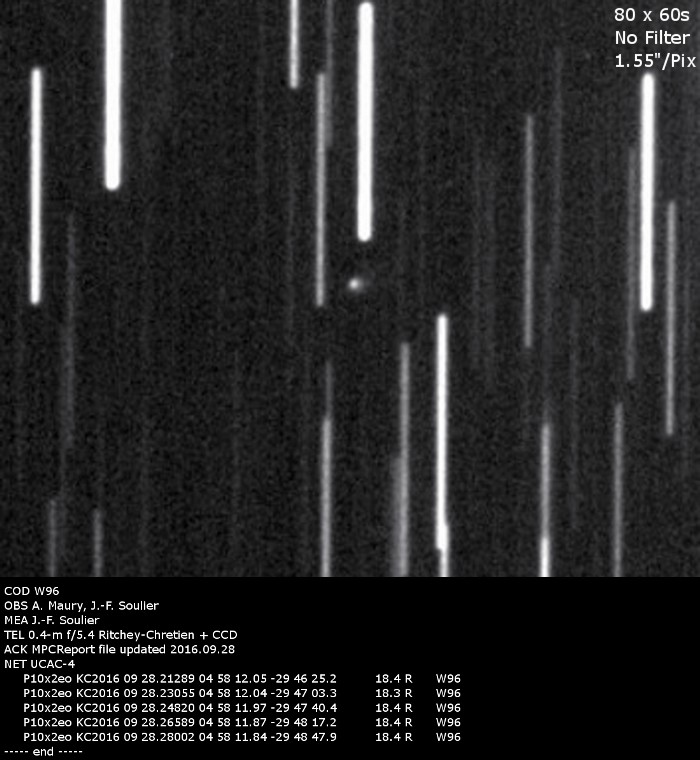Comet discovered in September 2016
C/2016 R2 PANSTARRS
R. Weryk and R. Wainscoat report the discovery of an apparent comet in exposures obtained with the 1.8-m Pan-STARRS1 telescope at Haleakala on Sept. 7 UT (CBET 4318); the object appear clearly cometary, with its coma visible out to at least 20" in radius. The available astrometry, the following preliminary elliptical orbital elements by G. V. Williams (from 21 observations spanning Aug. 30-Sept. 8), and an ephemeris appear on MPEC 2016-R107.
T = 2018 May 16.7568
Peri. = 33.0710
Node = 80.7156
Incl. = 58.1612
e = 0.978153
q = 2.635985 AU

©Jean Gabriel Bosch
C/2016 R3 BORISOV
Gennady Borisov reports his discovery of a diffuse comet with a coma diameter of 16" on three unfiltered 70-s exposures obtained on Sept. 11.06 UT through a 0.3-m f/1.5 Genon astrograph at the MARGO observatory (near Nauchnij, Crimea). The total red magnitude of the comet was 16.0 as measured in a circular aperture of size 0'.5.
After the object was posted on the Minor Planet Center's PCCP webpage, other CCD astrometrists have confirmed the object's cometary appearance. J.-F. Soulier obtained unfiltered images with a 0.30-m f/3.8 Newtonian reflector at Maisoncelles, France, on Sept. 14.14-14.16 that show a diffuse 35" coma with no tail; the red magnitude was 18.0 in a photometric aperture of radius 6".5. A. Hale, Cloudcroft, NM, USA, reports that he detected the comet visually at altitude 14 degrees in zodiacal light and early twilight with a 0.41-m reflector on Sept. 14.48, finding total magnitude about 12.9 with a 1'.4 coma.
The available astrometry, the following preliminary parabolic orbital elements by G. V. Williams, and an ephemeris appear on MPEC 2016-S03.
T = 2016 Oct. 10.9706
Peri. = 117.8863
Node = 78.6961
q = 0.448367 AU
Incl. = 53.0108
M. Meyer, Limburg, Germany, has suggested similarity of the orbital elements of this comet with those of comet C/1915 R1 (Mellish), for which a parabolic orbit was published by Einaarson and Alter (1915, Lick Obs. Bull. 8, 151) based on only three observations. Williams notes that the available observations for C/2016 R3 are consistent with intermediate-period orbits with periods as short as 50 years, possibly even 30 years. A new orbit by Williams for C/1915 R1, based on seven observations spanning 1915 Sept. 19-23 is given below for comparison:
T = 1915 Oct. 13.6001
Peri. = 116.1746
Node = 77.5290
q = 0.464924 AU
Incl. = 52.3278
Attempts by Williams and S. Nakano to definitively link the 1915 and 2016 apparitions (for zero, 1, 2, and 3 potential missed returns between 1915 and 2016) have not been successful. (CBET 4321)

©Jean-Francois Soulier
P/2016 R4 GIBBS
A. R. Gibbs reports his discovery of a comet(29th) on CCD images obtained with the Mt. Lemmon 1.5-m reflector on Sept. 10 UT; he noted a "fuzzy" coma of size 12" x 9". In follow-up images taken around Sept. 10.42-10.44, a 15"-long tail appears to start at p.a. 270 degrees before curving toward p.a. 250 deg.
After the comet was posted on the Minor Planet Center's PCCP webpage, other CCD astrometrists have commented on the cometary appearance.
L. Buzzi, Varese, Italy, notes that stacked images obtained by M. Lucchetta and himself with a 0.60-m f/4.64 reflector on Sept. 13.0 in good seeing show a compact coma 8" in size with a faint extension toward the east; the red magnitude was measured to be 18.8. J.-F. Soulier, Maisoncelles, France, measured a 21" coma (with red mag 18.3-18.6) and a possible diffuse tail longer than 19" in p.a. 250 deg in stacked unfiltered images obtained on Sept. 23.89-23.97 with a 0.30-m f/3.8 Newtonian reflector. (CBET 4325)
The available astrometry [including pre-discovery observations made on July 18.55-18.59 (magnitude 21.0-21.4) and Aug. 14.6 (magnitude 20.6-20.7) with the 1.8-m Pan-STARRS1 telescope at Haleakala; on Aug. 28.4 (mag 19.2-19.4) at Mount Lemmon; and on Sept. 10.3 (mag 18.9-19.2) at Crni Vrh, Slovenia], along with the following elliptical orbital elements by G. V. Williams and an ephemeris, appear on MPEC 2016-S94.
T = 2016 July 20.52099
Peri. = 174.06429
Node = 168.34700
Incl. = 10.86235
e = 0.4750068
q = 2.8005952 AU
a = 5.3345359 AU
P = 12.32 years
C/2016 S1 PANSTARRS
Robert Weryk and Eva Lilly report the discovery of another apparent comet exposures obtained with the 1.8-m Pan-STARRS1 telescope at Haleakala on Sept. 21 UT.
After the object was posted on the Minor Planet Center's PCCP webpage, other CCD astrometrists have also commented on the cometary appearance. (CBET 4324)
Eight stacked 180-s images taken by L. Buzzi, P. Concari, S. Foglia, G. Galli, and M. Tombelli with an iTelescope 0.15-m f/7 refractor at Siding Spring on Sept. 26.65-26.66 reveal an elongated shape of size 6" x 10", elongated toward p.a. 300 deg. Unfiltered CCD images taken by A. Maury and J.-F. Soulier on Sept. 28.2-28.3 with a 0.4-m f/8 Ritchey-Chretien reflector at San Pedro de Atacama, Chile, show a coma of size about 16" and a tail about 18" long in p.a. 270 deg; they measured red mag 18.4 in an aperture of readius 6".2. The available astrometry, the following preliminary elliptical orbital elements by G. V. Williams (from 46 observations spanning Sept. 21-29), and an ephemeris appear on MPEC 2016-S93.
T = 2017 Mar. 11.6136
Peri. = 272.2089
Node = 227.8788
e = 0.753105
q = 2.433961 AU
Incl. = 94.9299
a = 9.858268 AU
P = 30.95 years

©Jean-Francois Soulier
